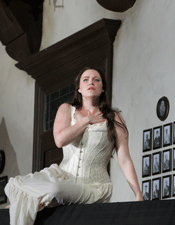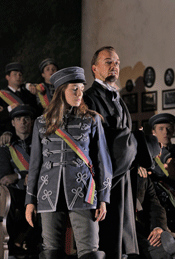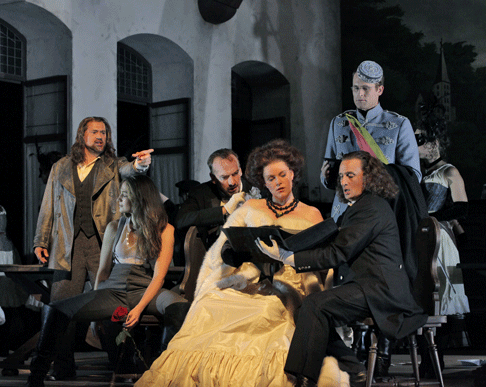![Paul Groves (Hoffmann) and Erin Wall (Giulietta) [Photo by Ken Howard courtesy of Santa Fe Opera]](http://www.operatoday.com/_MG_0429.gif)
22 Jul 2010
Hoffmann Takes A Hit In Santa Fe
Despite its length and pretentions to being serious opera, Jacques Offenbach’s The Tales of Hoffmann, dating from the 1880s, remains a leaky vessel adrift on a sea of self-fulfilling prophesies of doom.
English Touring Opera are delighted to announce a season of lyric monodramas to tour nationally from October to December. The season features music for solo singer and piano by Argento, Britten, Tippett and Shostakovich with a bold and inventive approach to making opera during social distancing.
This tenth of ten Live from London concerts was in fact a recorded live performance from California. It was no less enjoyable for that, and it was also uplifting to learn that this wasn’t in fact the ‘last’ LfL event that we will be able to enjoy, courtesy of VOCES8 and their fellow vocal ensembles (more below …).
Ever since Wigmore Hall announced their superb series of autumn concerts, all streamed live and available free of charge, I’d been looking forward to this song recital by Ian Bostridge and Imogen Cooper.
Although Stile Antico’s programme article for their Live from London recital introduced their selection from the many treasures of the English Renaissance in the context of the theological debates and upheavals of the Tudor and Elizabethan years, their performance was more evocative of private chamber music than of public liturgy.
Evidently, face masks don’t stifle appreciative “Bravo!”s. And, reducing audience numbers doesn’t lower the volume of such acclamations. For, the audience at Wigmore Hall gave soprano Elizabeth Llewellyn and pianist Simon Lepper a greatly deserved warm reception and hearty response following this lunchtime recital of late-Romantic song.
For this week’s Live from London vocal recital we moved from the home of VOCES8, St Anne and St Agnes in the City of London, to Kings Place, where The Sixteen - who have been associate artists at the venue for some time - presented a programme of music and words bound together by the theme of ‘reflection’.
'Such is your divine Disposation that both you excellently understand, and royally entertaine the Exercise of Musicke.’
‘And there was war in heaven: Michael and his angels fought against the dragon; and the dragon fought and his angels, And prevailed not; neither was their place found any more in heaven … that old serpent … Satan, which deceiveth the whole world: he was cast out into the earth, and his angels were cast out with him.’
There was never any doubt that the fifth of the twelve Met Stars Live in Concert broadcasts was going to be a palpably intense and vivid event, as well as a musically stunning and theatrically enervating experience.
‘Love’ was the theme for this Live from London performance by Apollo5. Given the complexity and diversity of that human emotion, and Apollo5’s reputation for versatility and diverse repertoire, ranging from Renaissance choral music to jazz, from contemporary classical works to popular song, it was no surprise that their programme spanned 500 years and several musical styles.
The Academy of St Martin in the Fields have titled their autumn series of eight concerts - which are taking place at 5pm and 7.30pm on two Saturdays each month at their home venue in Trafalgar Square, and being filmed for streaming the following Thursday - ‘re:connect’.
The London Symphony Orchestra opened their Autumn 2020 season with a homage to Oliver Knussen, who died at the age of 66 in July 2018. The programme traced a national musical lineage through the twentieth century, from Britten to Knussen, on to Mark-Anthony Turnage, and entwining the LSO and Rattle too.
With the Live from London digital vocal festival entering the second half of the series, the festival’s host, VOCES8, returned to their home at St Annes and St Agnes in the City of London to present a sequence of ‘Choral Dances’ - vocal music inspired by dance, embracing diverse genres from the Renaissance madrigal to swing jazz.
Just a few unison string wriggles from the opening of Mozart’s overture to Le nozze di Figaro are enough to make any opera-lover perch on the edge of their seat, in excited anticipation of the drama in music to come, so there could be no other curtain-raiser for this Gala Concert at the Royal Opera House, the latest instalment from ‘their House’ to ‘our houses’.
"Before the ending of the day, creator of all things, we pray that, with your accustomed mercy, you may watch over us."
The doors at The Metropolitan Opera will not open to live audiences until 2021 at the earliest, and the likelihood of normal operatic life resuming in cities around the world looks but a distant dream at present. But, while we may not be invited from our homes into the opera house for some time yet, with its free daily screenings of past productions and its pay-per-view Met Stars Live in Concert series, the Met continues to bring opera into our homes.
Music-making at this year’s Grange Festival Opera may have fallen silent in June and July, but the country house and extensive grounds of The Grange provided an ideal setting for a weekend of twelve specially conceived ‘promenade’ performances encompassing music and dance.
There’s a “slide of harmony” and “all the bones leave your body at that moment and you collapse to the floor, it’s so extraordinary.”
“Music for a while, shall all your cares beguile.”
The hum of bees rising from myriad scented blooms; gentle strains of birdsong; the cheerful chatter of picnickers beside a still lake; decorous thwacks of leather on willow; song and music floating through the warm evening air.
![Paul Groves (Hoffmann) and Erin Wall (Giulietta) [Photo by Ken Howard courtesy of Santa Fe Opera]](http://www.operatoday.com/_MG_0429.gif)
Despite its length and pretentions to being serious opera, Jacques Offenbach’s The Tales of Hoffmann, dating from the 1880s, remains a leaky vessel adrift on a sea of self-fulfilling prophesies of doom.
While gifted with some lovely melodic writing and opportunities for grand operatic singing, the story of a depressed alcoholic poet (“he never drinks water,” one line has it), and his tales of futile amorous adventure often seem over-stuffed with dialogue and redundant action. This opera is expensive and difficult to produce, and in the end bears only a negative message.
Just what Hoffmann’s message is has long been a subject of discussion. My view is that once the pretty surface of melody and musical charm is peeled back, below lies only vegetable cellulose, or nothing much. Some will argue that romantic fantasy is at the core of the piece; others find 19th century existential angst; Richard Wagner condemned it for a lack of “moral” value. I would tend to express it more in terms of the bad psychology of a neurotically disturbed man who through the confusions of alcohol and dissipation dooms his own romantic ambitions. However any of that may be, it is best to take Hoffmann as an exercise in visual pleasure and melodic delight — if there are singers and producers to make it happen, and a producer and music director to give it a light and stylish touch.
 Erin Wall as Antonia
Erin Wall as Antonia
In Santa Fe Opera’s heavy-handed production, the show turned out to be
badly cast and suffocatingly over-produced. None of the singers was adequate to
the task at hand; the voices were minor or flawed. The leading tenor, Paul
Groves, the key figure in the opera, who looked and played well, seemed to have
no upper register and was often short on volume. Professional that he is,
Groves soldiered through, but he was far from the real thing, in this most
lyrical of big French tenor parts.
Canadian soprano Erin Wall assumed the neigh-impossible task of singing the three major soprano roles the opera requires, the coloratura doll of Act I, Olympia, the lyric soprano of Act II, Antonia and the soprano or mezzo part of the Venetian courtesan, Giulietta, in Act III. She did not have the light agility or highest tones required by Olympia, as Santa Fe’s management must surely have known, and thus it seems a decision was made to turn her Olympia into Gilbert & Sullivan camp — if she did not have the clean runs or pin-point high notes, well mark it up to technical difficulties in her manufacturer Spalanzani’s design. All in good fun? Ho hum. In later acts Wall fared better, and demonstrated a solid top, through high-C, as Antonia though not much tonal allure or play of color; her voice seemed to thicken under pressure, which was much of the time. As an actress Wall was never more than bland.
 Kate Lindsey as Nicklausse, Wayne Tigges as Councilor Lindorf and Students
Kate Lindsey as Nicklausse, Wayne Tigges as Councilor Lindorf and Students
The only other singer I will address now is the bass-baritone Wayne Tigges,
a last minute replacement for an ailing colleague in the all-consuming and
vocally demanding roles of Offenbach’s four villains, who are in every
scene, with much to sing, and comprise the engine that drives the thrust of
“evil” though the show — that is quite aside from demon rum.
Tigges proved a boy sent to do a man’s job, and while earnest and
hard-working he did not have the magnetic personality or force or maturity of
voice to claim the part. He needs coaching in menace with John Malcovich.
With an inadequate tenor and bass, and soprano who was short on stage charisma and vocal interest, Offenbach’s score was not well-served. I have to say, and am sorry to do so, that Stephen Lord, music director of Opera Theatre of St. Louis, was a cut-and-dried conductor in the pit. While his orchestra played well enough, far too often Maestro Lord’s direction lacked vitality, dragged where it should have sparkled, left dead moments and, in general, lacked shape, flow and accent. Disappointing.
Now we come to Santa Fe’s stage producer, one of the most famous bad-boys of opera, Christopher Alden — who fully lived up to his reputation. I am going to keep this short — who needs a list of horrors? Alden’s direction was everywhere fussy and mannered, secondary characters moved in slow motion, slithered across the stage floor, pranced about their heads in picture frames, joined hands in a merry trio of dancing — and so on, endlessly. In the final moments of Act II, gilded high-style Second Empire opera boxes emerged from stage right holding an audience eager to applaud the diva Antonia, who had expired moments before. Ah so! We were watching a play within a play (who knew?) — and the Second Act, which Offenbach had already provided with an unnecessary anti-climax following Antonia’s death, offered yet another development as Antonia arose from the dead and took her bows. Now, let’s see, where did that plot go?
 Paul Groves as Hoffmann, Kate Lindsey as Nicklausse, Wayne Tigges as Captain Dapertutto, Erin Wall as Giulietta, David Cangelosi as Pitichinaccio and Darik Knutsen as Peter Schlémil (standing)
Paul Groves as Hoffmann, Kate Lindsey as Nicklausse, Wayne Tigges as Captain Dapertutto, Erin Wall as Giulietta, David Cangelosi as Pitichinaccio and Darik Knutsen as Peter Schlémil (standing)
Costumes? Elegant, lavish with Victorian flounces, bustles and ruffles everywhere. Set? Not bad, actually: it all transpired in Luther’s Tavern, a high handsome room with five massive beams across the ceiling, a dark wood dado around the room and white plastered walls that showed off various plaques and hangings. Platforms with minimal trappings for scenes following the Tavern’s opening one (the Kleinsach scene), were brought in and out; they proved effective, and in the Venetian scene featured a massive painting in the style of Turner depicting the grand canal. It worked!
Maybe we will write more about all this later in the season; these things have a way of ripening, and several of the secondary players deserve attention for some were excellent. For now SFO’s Tales of Hoffmann is a game hardly worth the candle.
© 2010 James A. Van Sant/Santa Fe